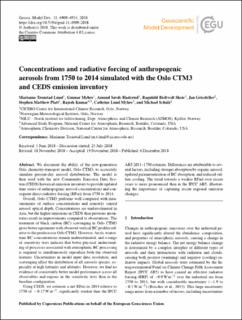Concentrations and radiative forcing of anthropogenic aerosols from 1750 to 2014 simulated with the Oslo CTM3 and CEDS emission inventory
Lund, Marianne Tronstad; Myhre, Gunnar; Haslerud, Amund Søvde; Skeie, Ragnhild Bieltvedt; Griesfeller, Jan; Platt, Stephen Matthew; Kumar, Rajesh; Myhre, Cathrine Lund; Schulz, Michael
Peer reviewed, Journal article
Published version
Permanent lenke
https://hdl.handle.net/11250/2754845Utgivelsesdato
2018Metadata
Vis full innførselSamlinger
- Journal articles [478]
Sammendrag
We document the ability of the new-generation Oslo chemistry-transport model, Oslo CTM3, to accurately simulate present-day aerosol distributions. The model is then used with the new Community Emission Data System (CEDS) historical emission inventory to provide updated time series of anthropogenic aerosol concentrations and consequent direct radiative forcing (RFari) from 1750 to 2014. Overall, Oslo CTM3 performs well compared with measurements of surface concentrations and remotely sensed aerosol optical depth. Concentrations are underestimated in Asia, but the higher emissions in CEDS than previous inventories result in improvements compared to observations. The treatment of black carbon (BC) scavenging in Oslo CTM3 gives better agreement with observed vertical BC profiles relative to the predecessor Oslo CTM2. However, Arctic wintertime BC concentrations remain underestimated, and a range of sensitivity tests indicate that better physical understanding of processes associated with atmospheric BC processing is required to simultaneously reproduce both the observed features. Uncertainties in model input data, resolution, and scavenging affect the distribution of all aerosols species, especially at high latitudes and altitudes. However, we find no evidence of consistently better model performance across all observables and regions in the sensitivity tests than in the baseline configuration. Using CEDS, we estimate a net RFari in 2014 relative to 1750 of −0.17 W m−2, significantly weaker than the IPCC AR5 2011–1750 estimate. Differences are attributable to several factors, including stronger absorption by organic aerosol, updated parameterization of BC absorption, and reduced sulfate cooling. The trend towards a weaker RFari over recent years is more pronounced than in the IPCC AR5, illustrating the importance of capturing recent regional emission changes.
